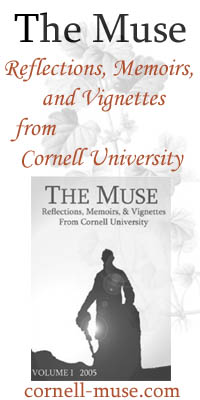Wrapping Ourselves in Numbers?
Not to beat a dead horse, but The Sun is running a rather interesting editorial today in response to the much talked about New York Times article. They start out strong enough:
Cornellians, the Image Committee especially, just want public perception to match the quality of the institution. It's not about trying to rank higher in US News & World Report, but making sure that the world knows just what Cornell is - a world-class educational research institution, with world-class students, faculty and facilities, all serving (and making a significant impact on) the world.
One former Cornell student quoted in the article commented, "Cornell is Ivy and more."
Cornell is exactly that - The Hill is the only Ivy League institution to come complete with a hotel school and an agriculture college, though the article incorrectly refers to CALS as "one of several at the university that are run by the state." Cornell has four colleges funded by the state of New York, however, the educational operation is governed entirely by Cornell, not by the State University of New York.
But then the editorial goes back on its tacit assertion to not care about rankings, and engages in a highly technical argument about why Cornell could never have an acceptance rate as low as some of our peers. Wasn't the whole point in the first place that we are above arbitrary rankings and that the University more than stands on its own merits?
Anyways, the editorial claims that size is the main reason:
The better question is: what is the quality of the accepted pool? For example, what percentage of admitted students were in the top 10 percent of their high school class? 85 percent of C.U.'s class of 2008 was in the top 10 percent of their high school's graduating class.
Columbia was only one percentage point more selective on that high school graduating class criterion, at 86 percent. Yet Columbia accepted less than half the percentage of their applicants than did Cornell this year (9.6 percent). The difference? Size. Columbia has fewer than 6,000 undergrads on its campus.
For Cornell to compete with Columbia's admissions rate while maintaining its current yield of an expected 44 percent, the University would need to receive 72,000 applications (72,000 applications x .096 acceptance rate x .44 yield = incoming class of 3,050). No Ivy receives even close to that many.
To a certain extent, the editorial is right. One of the difficulties in trying to lower the acceptance rate at Cornell is that it is a much larger school and there are only a finite number of highly qualified applicants to go around.
As a hypothetical exercise to better illustrate the editorial's point, consider two schools of different sizes both with the same acceptance rate and the same level of academic caliber among their students: School A and School B. School A is a smaller school than school B, and as such, receives less applications and admits less student. So while School A receives 1000 applications and admits 500 students, School B receives 2000 applications and admits 1000 students. This results in an acceptance rate of 50% for both schools.
Now let's say that both schools are successfully able to recruit 1000 additional applicants for the ensuing academic year. However, none of these applicants are accepted and both schools maintain the same caliber of students. What happens to their acceptance rates? Well, the smaller school, school A, now enjoys a 25% acceptance rate. But the larger school only enjoys a 33% acceptance rate. And even though nothing has changed about the educational environment about these two schools, School A is rewarded in the rankings game.*
But the article also misses a key point, that another difference motivating lower acceptance rates at other schools is the matriculation rate, or yield of its accepted students, which serves as a key indicator of a college's desirability among accepted students. As the article notes, Cornell has a 44% yield, but
Columbia College enjoyed a yield of 60 percent last year, meaning that Columbia is certain that 15 percent more of its accepted students will choose to enroll come May 1st. That makes a key difference when the directors of admissions decide how many students the university can admit -- and how low the acceptance rate can be as a result.
Perhaps the most telling indicator of Cornell's "desirability" is where common admits -- that is, students who are accepted to more than one school -- chose to go. Such a revealed preference indicates the demand for one school relative to another subject to the condition that a person was accepted at both schools. A Harvard economics professor, Caroline Hoxby, wrote a paper that looked at this very indicator, and Cornell
stacks up up fairly well according to this metric -- 12th among national universities, but well ahead of some schools that are routinely ranked ahead of Cornell in U.S. News and World Report, including Northwestern and Washington University in St. Louis.
So will the work of the Image Committee end up increasing Cornell's yield rate? Time will only tell, but at the very least, it will not hurt -- a strong logo, beautiful public website, and "cool hoodies" are all very good things for a college or university to have.
* Coincidentally, this very phenomenom explains Washington University's large rise in the rankings in the late 1990's -- Wash U figured out that a very easy way to increase their selectivity would be to encourage anybody and everybody to apply to their relatively small school.


